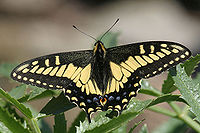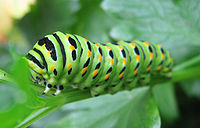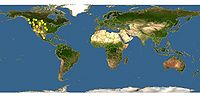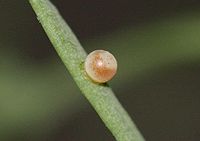Anise swallowtail
| Anise swallowtail |
|---|
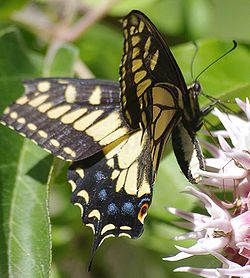
|
| Scientific Classification |
|
| Binomial Name |
|
Papilio zelicaon |
The Anise Swallowtail is a species of swallowtail butterfly known by the scientific name Papilio zelicaon. It is the most common swallowtail, and is often confused with the Tiger Swallowtail. The Anise Swallowtail is a very stunning butterfly and is beautiful to see in nature. It has an outline of black on the top part of its wing with lots of yellow, a little blue and barely any orange. Its wingspan is about seven to nine centimeters long but is smaller than the Tiger Swallowtail. The Anise Swallowtail is usually seen on\in hills, mountains, or fields in British Columbia and Mexico and a lot of the places in between.
Body Design
The body design of an Anise Swallowtail is unique among the different Swallowtail butterflies. An adult Anise Swallowtail is one of the smaller butterflies of the Swallowtails. It has a wingspan that can vary from two inches to almost four and a half inches.[1] [2] On the upper side(the dorsal side) of the Anise Swallowtail, on the hind wing, there is a yellow-orange eyespot that is located near the tail, the caudal end. The tail has a round black center that touches the hind wing. The end of the hind wing is generally yellow.[1] The Anise Swallowtail could be distinguished from other various Swallowtails because the it has an abundance of black on the cephalic end of the forewing and blue spots on the caudal end.[3]
There are many different species of Swallowtail butterflies, like the Tiger Swallowtail, the Giant Swallowtail, or the Black Swallowtail. The Black Swallowtail, obviously, is almost entirely all black. It has some yellow, blue, and orange at the caudal end. The Giant Swallowtail is more similar to the Anise Swallowtail. They both have black at the cephalic end. However, the Giant Swallowtail has only a little orange and blue that can only see from up close. The Tiger Swallowtail is much harder to tell apart. They are almost exactly identical. The only real difference is that the Anise Swallowtail has a small section of black on the top of the wing that comes from the body. [4]
Life Cycle
The life cycle of an Anise Butterfly is almost the same as any other butterfly. It has complete metamorphosis(the process of transformation from an immature form to an adult form in two or more distinct stages). The males perch on hilltops and look/wait for females. After mating the females will then lay their eggs one by one on plant leaves and/or flowers.[1] As an egg, the Swallowtails are a creamy-beige or a pale yellow color that is a spherical pearl-like shape. This color is similar to most other butterfly eggs. The egg will then begin to darken. After a week or two the egg hatches into a tiny caterpillar which then eats the shell. This caterpillar is very small and black because it is in the first instar stage.
As a tiny caterpillar, it goes into its second instar caterpillar stage and looks almost spiky and has a black-white-black pattern. After the caterpillar molts the white is more noticeable and a little amount of an orange color appears. The body of the caterpillar is about two inches long and is very chubby and fat. This is the caterpillar people usually see, which is shown on the left. When it forms its cocoon, the caterpillar sheds its skin and exposes the chrysalis underneath. This stage takes about ten minutes. To complete the entirety of the cocoon, it takes around a half hour. Depending on the caterpillar, they hatch at different times. When they emerge from the cocoon, they fly away after they dry their wings. [5] [2]
Ecology
People see butterflies all the time in the summer. The Anise Swallowtail usually fly around March through June, which is why kids like to catch butterflies in the summer. Anise Swallowtails are usually found where their host plants are. They can be found where the females lay their eggs which can be on fennel, which is a European weed. Ammi, which is a another kind of weed, attracts ovipositing females. However this kind of weed is highly toxic to the larvae. Another plant they feed on is lomatium which are perennial herbs and are only available for only a few weeks in the spring time.[6]
They eat and lay their eggs on a great variety of apiaceae, commonly known as carrot or parsley family. In Washington they are found eating lomatium, perideridia, which is a kind of parsley, and tauschia (also known as umbrellaworts). In Donner and Castle Peak, which are in Colorado and Nevada, they eat angelica, which is a kind of parsley, cymopterus, which is a type of perennial plant, and lomatium. In Sierra Valley, which is in Northern California, they eat lomatium and conium which is a highly toxic biennial. In Northern Sacramento Valley they are found eating on cultivated citrus.[6] Overall, if you want to find a butterfly usually you will find them on plants that they eat or nest on. If you want to find a specific butterfly, then you will need to find out what plants they like and search around those plants during the summertime.[6]
Nesting
Just like how the Anise Swallowtail only eats a particular kind of food group it also has particular plants where the females lay their eggs. Not only do they eat parsley, but parsley is one of the places these butterfly lay their eggs. Someone can easily identify parsley because they have distinctive flowerheads. If a person is taking a walk or just out enjoying the nature and they know what parsley looks like, they should look around to see if you see any butterflies. However if one were to do this, the best chance is if its in between March and June. Like said before, this is when they come out and are seen almost all the time.[4]
As mentioned previously, lomatium is another kind of parsley, however it looks a little bit different. This kind of parsley, if found in a grassy area, would be very difficult to point out. Lomatium has a yellow flower head but camouflages with the grass. On that walk that someone might go on, look for eggs. If they are in a mountainous area and they know that either Anise Swallowtails fly around that area or any butterflies at all, first they should look for parsley. If they find some they will want to look on the underside of the leaves, right near the flowers, or possibly on a stem. This is where the females usually lay their eggs. The egg will be very small and a magnifying glass would probably be needed to spot one.[4]
Video
References
- ↑ 1.0 1.1 1.2 1.3 Balaban, John and Jane.Species Papilio zelicaon - Anise Swallowtail BugGuide. Web. 17 September, 2010(last-update).
- ↑ 2.0 2.1 Anise Swallowtail (Papilio zelicaon) My Butterfly Guide: Southern California Butterflies. Web. 4 December, 2012(Date-of-access).
- ↑ Wilson, Bert. - Anise Swallowtail, Papilio zelicaon Las Pilitas Nursery. Web. 8 January, 2012 (Date-of-last-update).
- ↑ 4.0 4.1 4.2 - Anise Swallowtail Raising Butterflies. Web. 6 December, 2012(Date-of-access).
- ↑ Vaughn, Chuck. - Chuck's Butterfly Page Chuck's Butterfly Page. Web. 4 December, 2012(Date-of-access).
- ↑ 6.0 6.1 6.2 Papilio zelicaon Art Shapiro's Butterfly Site. Web. 13 December, 2012(Date-of-access).
